*** Special to The BRAD BLOG
*** by Libby/CIA Leak Trial Correspondent Margie Burns
 A startling detail emerged from testimony Wednesday in U.S. v. Libby: the CIA briefer for Vice President Richard Cheney and Lewis Libby, Cheney’s chief of staff, kept each Table of Contents from his briefing binders when he sent the contents of the binders to shredder and burn bag. CIA manager Craig Schmall testified, matter-of-factly, in response to defense attorney questioning about those informative subject headings: “They still exist.”
A startling detail emerged from testimony Wednesday in U.S. v. Libby: the CIA briefer for Vice President Richard Cheney and Lewis Libby, Cheney’s chief of staff, kept each Table of Contents from his briefing binders when he sent the contents of the binders to shredder and burn bag. CIA manager Craig Schmall testified, matter-of-factly, in response to defense attorney questioning about those informative subject headings: “They still exist.”
Schmall’s cross-examination by Libby’s attorneys corroborates that the CIA morning briefing covered dozens of topics each day deemed important to U.S. security. Twenty-seven topics from a single day mentioned by Libby’s lawyer included terrorist strikes and threats, any actions deemed worthy of attention by foreign governments or other entities, and any significant actions by North Korea, Iran, and Iraq.
Schmall, as noted in a previous post, was I. Lewis "Scooter" Libby’s morning intelligence briefer six days a week from summer 2002 through fall 2003 and served Vice President Cheney as intelligence briefer to the end of May 2004. In winter 2002-2003, he briefed both Libby and Cheney on Mondays and Tuesdays of each week and briefed Libby on Saturdays at Libby’s home. The briefings began at 7:00 a.m. and lasted about 40 minutes; results and taskings were then typed into a database and pooled with results from briefers of other senior government officials (“principals”).
Presumably CIA briefers raised equally critical topics each morning for the president, the Secretary of State, the National Security Advisor and the Secretary of Defense.
Each topic was clearly titled in the Table of Contents in the daily briefing binder. Investigators should look at those tables of contents in regard to White House efforts to cover up the unraveling of the Iraq WMD fable. When bogus intelligence was floated, for example, or when reports corrected the misinformation, presumably those items were reflected in the briefings.
Schmall testified that the principals spent most of the time in briefings reading their binders, with any questions or requests noted for follow-up by the Intelligence Community.
The fragmentary list below illustrates a few of the critical events that Bush, Cheney, their top aides and their Cabinet members may have known and reacted to. The basic starting question is the same for each item:
Did this appear in a table of contents for a briefing, and if so, on what date?...
- Jan. 2, 2001 – Niger embassy in Rome ransacked; Italian police discover that items stolen include embassy stationery and files. Later the stationery appears to turn up in some forged documents pertaining to Niger uranium and Iraq.
- [late] Jan. 2001 – Italian govt acquires documents, easily determined to be forgeries, purporting to be correspondence re Iraq purchasing Niger uranium.
- Nov. 20, 2001 – French say “no possibility” any yellowcake diverted to Iraq.
- Oct. 9, 2002 – U.S. Embassy in Rome receives copies of forged documents; Italian journalist Elisabetta Burba receives the Niger documents from a security consultant, passes them along to the U.S. embassy hoping to get them vetted.
- May 6, 2003 – NYTimes column refers to Joe Wilson re Niger story as wrong; without naming Wilson, Nicholas Kristof’s column mentions Wilson’s Africa trip.
- June 9, 2003 [about] --- Joe Wilson gets in touch with David Shipley, ed of the NYTimes op-ed page, who offers him “fifteen hundred words to tell my story” (Wilson’s book, 332).
- June 10, 2003 – State Dept memo refers to Mrs. Wilson; a memorandum written for Marc Grossman, then under secretary of state for political affairs, refers explicitly to Valerie Wilson as Mr. Wilson's wife. Memo written by an analyst in the INR (Bureau for Investigation and Research) in State Dept.
- June 13, 2003 --- Iraqi mobile labs nothing to do with germ warfare, report finds; article in (London) Observer by Peter Beaumont, Antony Barnett and Gaby Hinsliff.
- June 14, 2003 – at an EPIC conference, Ray McGovern meets Joe Wilson, the former CIA analyst asks Wilson when he plans to go public re Niger; Wilson tells him in about 2 weeks.
- July 5, 2003, at “about 10:30 p.m.,” Wilson’s oped hits the NYtimes web site; at 10:32 he gets a call from a NYPost reporter; at 10:34 he gets a call from Meet the Press inviting him to be on the next day (Wilson’s bk, 333).
- July 14, 2003 – Sen. Bob Graham says publicly that Bush shd be impeached; also Robert Novak’s column appears, mentioning Mrs. Wilson as a CIA operative.
- July 18, 2003 – newspapers report that the Niger docs were obv forgeries, highlight dif statements from CIA and State; e.g. Scottsbluff, Nebraska Star-Herald, Friday July 18, 2003.
- Aug. 2003 – rightwing outlets publish attacks on INR, which demurred at administration representations about Iraq WMD.
- Nov. 7, 2003, a Friday --- John J. Kokal of the INR found dead at bottom of State Dept bldg, acc to Fox News, WashPost; Soc Sec gives date of death as Nov. 8, 2003. (“Fire Department Spokesman Alan Etter said the man, a white male, was wearing a dress shirt, tie and slacks, but was not wearing shoes nor a suit jacket. He was found lying in the bottom of a concrete window well near 23rd and D streets, about eight stories below the top of the building. The well drops about 20 feet from ground level.” – Fox News).
N.b.: Obviously the bogus Niger uranium story, including its aftermath, is but one part of the administration’s push to war. But even this one narrow investigative path has led to the undermining of federal agencies, loss of (further) public trust in government and news media, loss of livelihood and possibly worse.


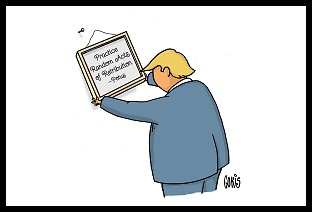 Sunday 'Random Acts of' Toons
Sunday 'Random Acts of' Toons From CA's 'Nuclear Deterrence' Map to Newsom's Trolling to Trump's 'Fascist Theatre' and Beyond: 'BradCast' 8/21/25
From CA's 'Nuclear Deterrence' Map to Newsom's Trolling to Trump's 'Fascist Theatre' and Beyond: 'BradCast' 8/21/25 'Green News Report' 8/21/25
'Green News Report' 8/21/25
 On 'Americanism' and Trump's 'Stalinesque' Plot to Whitewash U.S. History: 'BradCast' 8/20/25
On 'Americanism' and Trump's 'Stalinesque' Plot to Whitewash U.S. History: 'BradCast' 8/20/25 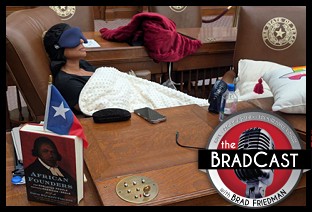 Texas GOP Imprisons Dem State Lawmaker in State House Chamber: 'BradCast' 8/19/25
Texas GOP Imprisons Dem State Lawmaker in State House Chamber: 'BradCast' 8/19/25 'Green News Report' 8/19/25
'Green News Report' 8/19/25 Trump, Nazis and
Trump, Nazis and 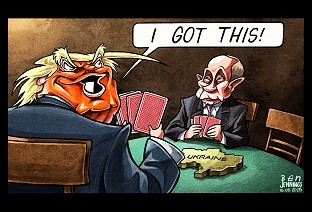 Sunday '
Sunday '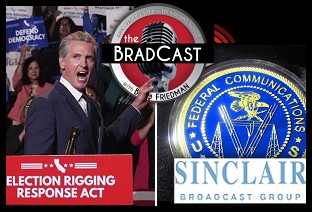 Newsom's 'Election Rigging Response Act'; FCC's License Renewal for Sock-Puppeting Sinclair: 'BradCast' 8/14/25
Newsom's 'Election Rigging Response Act'; FCC's License Renewal for Sock-Puppeting Sinclair: 'BradCast' 8/14/25 'Green News Report' 8/14/25
'Green News Report' 8/14/25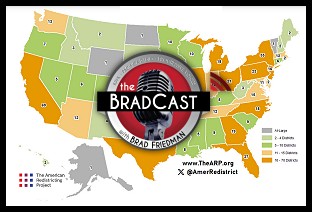 140 New House Reps?: Moving Beyond the Gerrymandering Wars: 'BradCast' 8/13/25
140 New House Reps?: Moving Beyond the Gerrymandering Wars: 'BradCast' 8/13/25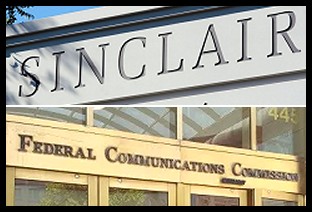 FCC Renews Sinclair TV Licenses Despite Complaint from Petitioner Who Died Waiting
FCC Renews Sinclair TV Licenses Despite Complaint from Petitioner Who Died Waiting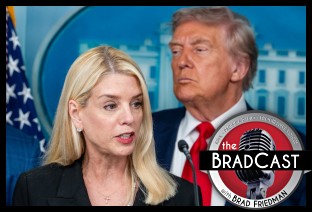 It's Not About the Rule of Law, It's About Authoritarian Control: 'BradCast' 8/12/25
It's Not About the Rule of Law, It's About Authoritarian Control: 'BradCast' 8/12/25 'Green News Report' 8/12/25
'Green News Report' 8/12/25 After Vaccine Cancels, CDC Shooting, Former Officials Want RFK Out: 'BradCast' 8/11/25
After Vaccine Cancels, CDC Shooting, Former Officials Want RFK Out: 'BradCast' 8/11/25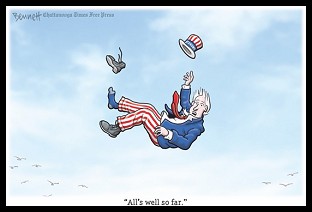 Sunday 'All's Well' Toons
Sunday 'All's Well' Toons 'Green News Report' 8/7/25
'Green News Report' 8/7/25 Trump Wars Against Greem Energy, Democracy on VRA's 60th: 'BradCast' 8/7
Trump Wars Against Greem Energy, Democracy on VRA's 60th: 'BradCast' 8/7 Media Conglomerates Continue Trump Capitulation: 'BradCast' 8/6/25
Media Conglomerates Continue Trump Capitulation: 'BradCast' 8/6/25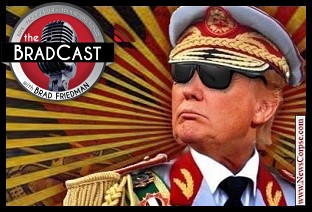 Banana Republican: Trump Shoots the Labor Statistics Messenger: 'BradCast' 8/5/25
Banana Republican: Trump Shoots the Labor Statistics Messenger: 'BradCast' 8/5/25 All's Fair in Love, War and, Apparently, Part-isan Gerrymandering: 'BradCast' 8/4/25
All's Fair in Love, War and, Apparently, Part-isan Gerrymandering: 'BradCast' 8/4/25 The Art of the Corrupt, Phony, Unlawful, Pretend Trade Deal: 'BradCast' 7/31/25
The Art of the Corrupt, Phony, Unlawful, Pretend Trade Deal: 'BradCast' 7/31/25 Battle Begins Against Trump EPA Climate Regulations 'Kill Shot': 'BradCast' 7/30/25
Battle Begins Against Trump EPA Climate Regulations 'Kill Shot': 'BradCast' 7/30/25 A Pu Pu Platter of Trump Corruption: 'BradCast' 7/29/25
A Pu Pu Platter of Trump Corruption: 'BradCast' 7/29/25 'Catastrophic' GOP Cuts to Medicaid, Medicare, ACA: 'BradCast' 7/28/25
'Catastrophic' GOP Cuts to Medicaid, Medicare, ACA: 'BradCast' 7/28/25
 VA GOP VOTER REG FRAUDSTER OFF HOOK
VA GOP VOTER REG FRAUDSTER OFF HOOK Criminal GOP Voter Registration Fraud Probe Expanding in VA
Criminal GOP Voter Registration Fraud Probe Expanding in VA DOJ PROBE SOUGHT AFTER VA ARREST
DOJ PROBE SOUGHT AFTER VA ARREST Arrest in VA: GOP Voter Reg Scandal Widens
Arrest in VA: GOP Voter Reg Scandal Widens ALL TOGETHER: ROVE, SPROUL, KOCHS, RNC
ALL TOGETHER: ROVE, SPROUL, KOCHS, RNC LATimes: RNC's 'Fired' Sproul Working for Repubs in 'as Many as 30 States'
LATimes: RNC's 'Fired' Sproul Working for Repubs in 'as Many as 30 States' 'Fired' Sproul Group 'Cloned', Still Working for Republicans in At Least 10 States
'Fired' Sproul Group 'Cloned', Still Working for Republicans in At Least 10 States FINALLY: FOX ON GOP REG FRAUD SCANDAL
FINALLY: FOX ON GOP REG FRAUD SCANDAL COLORADO FOLLOWS FLORIDA WITH GOP CRIMINAL INVESTIGATION
COLORADO FOLLOWS FLORIDA WITH GOP CRIMINAL INVESTIGATION CRIMINAL PROBE LAUNCHED INTO GOP VOTER REGISTRATION FRAUD SCANDAL IN FL
CRIMINAL PROBE LAUNCHED INTO GOP VOTER REGISTRATION FRAUD SCANDAL IN FL Brad Breaks PA Photo ID & GOP Registration Fraud Scandal News on Hartmann TV
Brad Breaks PA Photo ID & GOP Registration Fraud Scandal News on Hartmann TV  CAUGHT ON TAPE: COORDINATED NATIONWIDE GOP VOTER REG SCAM
CAUGHT ON TAPE: COORDINATED NATIONWIDE GOP VOTER REG SCAM CRIMINAL ELECTION FRAUD COMPLAINT FILED AGAINST GOP 'FRAUD' FIRM
CRIMINAL ELECTION FRAUD COMPLAINT FILED AGAINST GOP 'FRAUD' FIRM RICK SCOTT GETS ROLLED IN GOP REGISTRATION FRAUD SCANDAL
RICK SCOTT GETS ROLLED IN GOP REGISTRATION FRAUD SCANDAL VIDEO: Brad Breaks GOP Reg Fraud Scandal on Hartmann TV
VIDEO: Brad Breaks GOP Reg Fraud Scandal on Hartmann TV RNC FIRES NATIONAL VOTER REGISTRATION FIRM FOR FRAUD
RNC FIRES NATIONAL VOTER REGISTRATION FIRM FOR FRAUD EXCLUSIVE: Intvw w/ FL Official Who First Discovered GOP Reg Fraud
EXCLUSIVE: Intvw w/ FL Official Who First Discovered GOP Reg Fraud GOP REGISTRATION FRAUD FOUND IN FL
GOP REGISTRATION FRAUD FOUND IN FL

































